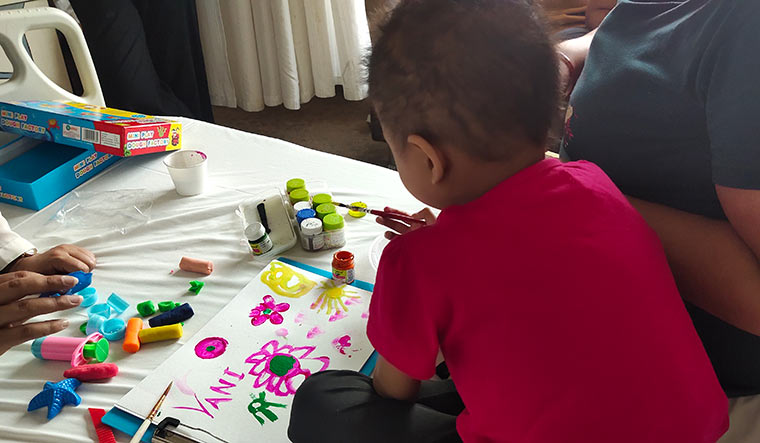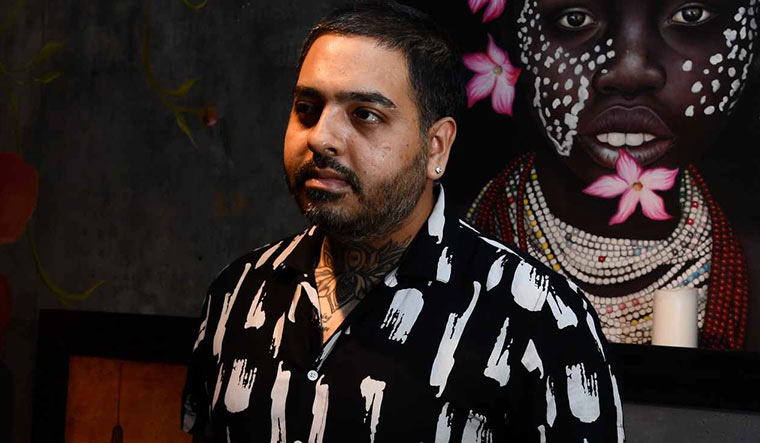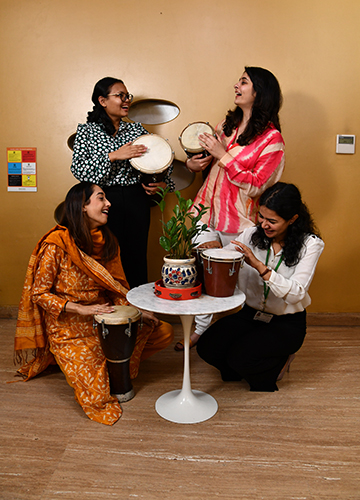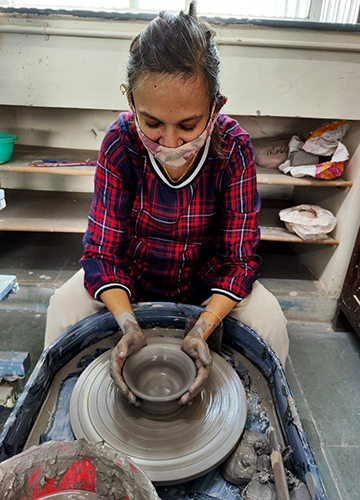When Aleena Ali and Tanushree Sangma first came to her with an “art cart”, five-year-old Tushara Gaur showed little interest. But when Ali started taking out items from the cart and asked the little one to choose, Tushara's face lit up with a beautiful smile; she pointed to a water-colour brush.
Tushara has blood cancer, and has spent most of the last nine months in various hospitals. She is currently an in-patient at the Fortis Memorial Research Institute (FMRI), Gurugram.
Both Ali and Sangma, expressive art therapists, encouraged her parents to join Tushara. The mother sat next to her on the hospital bed, and the duo started drawing. The mood in the room changed. Sangma tied balloons to the IV stand and Ali introduced a DIY clay extruder. Her effort to shoot clay from it made Tushara laugh. By the time they left, the therapists had built a rapport—and thereby begun a therapeutic relationship—with Tushara. Through the session, the child had not spoken a word. But she did communicate through non-verbal ways and “art”.
There is no general agreed-upon definition of the term “art”. Russian writer Leo Tolstoy called it an indirect means of communication between people. Some others say it represents the expression of thoughts, emotions, intuitions and desires. “When you are creating art, you are freeing yourself,” says Bose Krishnamachari, painter, curator and co-founder of the Kochi Biennale Foundation. “As an artist, I would say that when I am working, I am in my space. Being yourself is one of the most beautiful things.”
For thousands of years, humans have used idols, charms, sacred symbols, chants and music in healing rituals. Professional “art therapy”, though, was only established in the mid-20th century. A unique therapeutic approach, it incorporated elements of movement, music, visual art, theatre, poetry and psychodrama in healing. It started as a way to treat veterans of the world wars who were suffering from post-traumatic stress disorder and to help children and teens with special needs.
What is art therapy?
Art therapy is essentially an umbrella term we use to define different art modalities or expressive capacities,” says Aditi Kaul, who leads the expressive arts therapy programme at FMRI. “The idea is not that a person [undergoing therapy] should be good at a particular art form. He should just be able to use an art form as a language to express himself, process things and work through that to get to a place where he would feel the healing.”
Dr Christianne Strang, an art therapist with over 30 years of experience and a professor at the University of Alabama at Birmingham, says anybody can use art for healing, but when it comes to art therapy, there are specific treatment goals. “And those goals are arrived at with the client—art therapy is not something we do ‘to a client’, but something we do ‘with a client' in a therapeutic relationship,” she says. “And then the art materials in the process become part of that relationship.”
Dr Samir Parikh, director of the department of mental health and behavioural sciences, Fortis Healthcare, says that art therapy is used to treat a range of mental health issues such as depression, substance abuse, anxiety and schizophrenia. However, the scope of art therapy goes beyond mental health care, he says. “We provide art therapy sessions to all children and teens admitted at Fortis,” he says. “We also provide art-based sessions to patients who are suffering from conditions like cancer, trauma, dementia and stroke.”
He adds that art therapy should be used to supplement conventional methods of treatment. “For example, in a stroke case, the patient might be receiving physiotherapy and counselling,” he says. “Along with that, he may receive an art therapy session to improve his motor skills, cognitive functioning and movement. We also use art therapy sessions and workshops to facilitate self-discovery and growth.”
The emergence of modern art therapy
British artist Adrian Hill is said to have coined the term “art therapy” in 1941. While undergoing treatment for tuberculosis at King Edward VII sanatorium in Sussex, Hill had started drawing to pass the time. He found that the process improved his mood and aided in his recovery. The war painter then started exploring how he could help other patients with this discovery. “Hill published his theories in his book Art Versus Illness, which later was mandated for nursing staff in hospital units,” says Kaul. Hill also found that merely looking at art had some positive effect, and asked hospitals to hang artwork on their walls. “The hospitals were sad, white, dull places,” says Kaul. “Thanks to Hill, colour exists in hospitals across the world now.”
Rishi Taneja, 35, found the healing power of art just like Hill did—accidentally. “I have always been an artist; in fact, I went to an art school called Camberwell College of Arts in London,” says the Delhi-based fashion photographer. “But the first time I experienced the true value of art is when I dealt with grief.”
Taneja lost his mother in 2010 and his father the next year. “Though I have been on a lot of medication for anxiety and depression ever since, and attended many therapy sessions, painting has helped the most in terms of dealing with grief,” he says.
American psychoanalyst Margaret Naumburg played a crucial role in developing art as a therapeutic modality backed by scientific study. Between 1941 and 1947, she worked at the New York State Psychiatric Institute and published a series of case studies in which she used art for diagnosis and therapy. “Naumburg brought together psychotherapeutic concepts and visual art and a little bit of movement [therapy] and gave it that art therapy stamp,” says Kaul. A major question art therapists faced was how to decide the appropriate media for their patients, and under what circumstances an art-based activity using that media could be therapeutic. The answer came in 1978, in the form of a theoretical framework called expressive therapies continuum (ETC). Developed by art therapists Sandra Kagin and Vija Lusebrink, ETC helped therapists identify which part of the brain and which brain functions were affected, and to choose a therapy plan accordingly. “ETC looks at the neuroscientific aspects of art therapy,” says Kaul. “For a long time, it was believed that the brain remained plastic only during childhood and adolescence. But research shows that the brain has neuroplasticity (the ability of neural networks in the brain to change) throughout lifetime. So, the brain decides what pathways and connections need strengthening, and which ones do not. New studies show that people engage both sides of the brain when they use creativity and engage in an art-based activity. So, creativity can be used to develop new neural pathways and to replace or bypass problematic neural pathways in the brain.”
Girija Kaimal, assistant dean for Special Research Initiatives, Drexel University in Pennsylvania, says the human brain is like a prediction machine. “Every day, we are taking in information from our senses, our memories, and from things we learn, know and have experienced to prepare for an uncertain future,” she says. “Art helps us try out different scenarios for the future in creative ways. In the process, different neurobiological systems come into play.”
Being creative, she says, is a natural state as the brain is constantly figuring out solutions to problems that inevitably come to us every day. “Now the tricky thing is if we overestimate negative outcomes, we get things like anxiety,” she says. “If we see no hope for the future, we get depressed. If our imagination sort of loses touch with reality, we go to psychosis or schizophrenia. So, neurobiologically, when we create, we activate reward pathways in our brain. Reward pathways are dopaminergic pathways. Dopamine is released when we create something that makes us feel good. It is activated when we use our motor systems as well as our imagination system.”
Kaimal adds that when we communicate our inner state in an art therapy session with a compassionate and non-judgmental therapist, our stress level goes down. “You will see levels of [stress hormone] cortisol going down,” she says. “Our studies have shown that.”
Also, as per a study published in the Journal of the American Medical Association in 2020, art therapy is found to have produced better outcomes in treating PTSD among military servicemen compared with popular verbal psychotherapies.
Common therapy techniques
Kaul and Sangma performed a mock “mirroring game”—a common exercise in dance/movement therapy and drama therapy—for THE WEEK team at Sukoon Health, a psychiatric hospital governed by FMRI. It started with Sangma raising her right hand and moving her body to her right. Kaul imitated her. Then Sangma moved to the left. Kaul did, too. Soon, their moves became like a dance. This was followed by a discussion about their emotional states while doing the “dance”.
The mirroring game, say experts, enhances communication, empathy and understanding of others’ emotional intentions. Kaul recalled the case of a couple. “They were struggling with their relationship,” she says. “Their core issue was that they could not consummate their marriage for three years. There was a lack of communication. We initially tried conventional talk therapies. But none of them worked. So we decided to employ dance movement therapy techniques like mirroring, in addition to some visual art techniques. This was highly effective in making them understand each other’s patterns and mental states. Communication also became smoother. Their sessions lasted for around nine months and now they have a baby girl.”
Arts therapists use various techniques like the mirror game to create treatment protocols best suited for their patients. To deal with emotional issues like anger, therapists may ask clients to make a “stress painting” by choosing the colours representing their stress, design a postcard that the patient will never send, make sock puppets to act out stressful situations or put together a journal. Likewise, for patients in distress, one of the most commonly used techniques is to ask the patients to draw a “safe space” and place the people and things that make them comfortable in it.
Art therapy techniques are also used together with cognitive behavioural therapy to treat victims of sexual abuse. Expressive arts therapist Avantika Malhautra spoke of a case where she worked with a young woman who had body image issues and low self-esteem. “Because of a history of sexual abuse, she had not accessed certain parts of her body, as she felt numbness in those parts,” says Malhautra. “Over four months, and after several sessions of working together, art, movement and drama techniques became a container for her to express her true feelings, which she had not felt safe to express earlier. This created a shift in her and brought back a sense of agency and belonging to her body.”
Art-based therapies for different outcomes
Therapists say that play therapies are effective with children. A trained therapist can use this time to gain insight into a child’s problems and can help him deal with unresolved trauma. “I have worked with children who experienced a lot of guilt, anger and confusion on the separation of their parents,” says Malhautra. “I found that creating a story using angry or sad masks, or projecting their home life through drawing or clay using metaphors of animals was helpful in self-expression and asking for what they need.”
There is growing awareness that art-based therapies can supplement cancer care, too. “Cancer is a physical illness, of course. But it is one of those unique illnesses that really forces people to reevaluate life,” says Kaimal. “So when people engage in artistic practices, they often talk about life and getting a second chance and doing things they might not have thought of.”
A 2017 study conducted by Kaimal’s team, studying 22 cancer patients, found that participants felt more positive and more confident after they had 45-minute sessions of colouring or free art-making with an art therapist.
Art can also help athletes, says mental conditioning and peak performance coach Dr Swaroop Savanur. “Athletes are generally goal-oriented people,” he says. “Therefore, their mind is always focused on goals and performance. And, that can trigger a lot of thoughts that can affect their focus. So, the principle for helping them is to be calmer, to be in the present. Art can help them get away from these thoughts and be mindful.”
Savanur, who has been the mental conditioning coach for the IPL team Punjab Kings, says he uses art mainly in team-building sessions. “Last year, when our players were in quarantine, I had used art to make them more creative. I built some kind of team-building activity around it, which they enjoyed.”
Art can also help players from different countries and backgrounds communicate. “These team-building activities are created to ensure that they can understand each other not just as a player, but as a person,” says Savanur.
Sudha Meiyappan, who founded the NGO Parivartan For Parkinson’s Foundation, says that art-based therapies are effective in improving the quality of life of those affected with PD. “Parkinson’s disease is caused by reduction in dopamine secretion,” she says. “The disease affects the motor skills from the beginning itself. As the disease progresses, it will become worse. The reduction in dopamine would affect the patient’s mental wellbeing also. It is known to cause depression in over 50 per cent of population affected with PD. It is proven that art practices are helpful not only in dealing with the reduction in dopamine levels, but also in improving the cognitive and motor skills of patients. That’s why we are conducting art-based sessions.”
S. Sudandra Babu, 62, a PD patient, agrees. “The disease started in 2018 with tremors in the hands,” he says. “After that, I started feeling anxiety and dizziness. I started attending the art sessions in Parivartan last year. I felt comfortable while drawing in the sessions. In my childhood, I used to draw pictures. After around 50 years I am back into drawing.” Babu says that it is not easy for him to hold the drawing materials tight, or to draw continuously. But drawing for three to four hours is part of his daily routine now. “Every day, it is a daunting task to start drawing. I have to wait till the tremor stops,” says Babu. “But still, I will do it. Because I feel good when I draw.”
Smita Vinchurkar, 46, a Mumbai-based photographer, says that she used to think of art-based therapeutic intervention as a sham. But her own experience, specifically after she started taking pottery lessons, made her a believer. “I lost my job during the pandemic,” she says. “And, I was affected with a lot of negative feelings. That is when I decided to attend a one-day trial session at a pottery studio. I found that the tactile experience of pottery was meditative. It also connected me to my childhood. It gave me a new perspective in my life.” She now wants art education to be made compulsory in schools as it will help children be better equipped to cope with stressful situations in future. “Art,” she says, “is for everyone; art heals.”
Some names changed on request and for privacy







